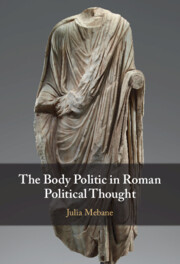Book contents
- The Body Politic in Roman Political Thought
- The Body Politic in Roman Political Thought
- Copyright page
- Dedication
- Contents
- Acknowledgments
- Introduction
- Chapter 1 The Divided Body Politic
- Chapter 2 The Sick Body Politic
- Chapter 3 The Augustan Transformation
- Chapter 4 Julio-Claudian Consensus and Civil War
- Chapter 5 Addressing Autocracy under Nero
- Conclusion
- Works Cited
- Index Locorum
- Index
Chapter 5 - Addressing Autocracy under Nero
Published online by Cambridge University Press: 01 February 2024
- The Body Politic in Roman Political Thought
- The Body Politic in Roman Political Thought
- Copyright page
- Dedication
- Contents
- Acknowledgments
- Introduction
- Chapter 1 The Divided Body Politic
- Chapter 2 The Sick Body Politic
- Chapter 3 The Augustan Transformation
- Chapter 4 Julio-Claudian Consensus and Civil War
- Chapter 5 Addressing Autocracy under Nero
- Conclusion
- Works Cited
- Index Locorum
- Index
Summary
Chapter 5 locates the Younger Seneca and Lucan in a shared conversation about the long-term ramifications of sole rule. It opens with a reading of Seneca’s De Clementia, which is the first text to theorize the metaphors of the healer and head of state. Using both to construct a persuasive ideal of imperial interdependence, Seneca described a body politic whose health vacillates in proportion to the virtue of its princeps. The sick heads and overzealous surgeons that crop up in his other works, however, confirm the risks of such an arrangement. Lucan took this idea as his point of departure in the Bellum Civile, which responds to the imagistic framework of De Clementia through the characters of Sulla and Pompey. Portraying the former as a surgeon who makes excessive use of the scalpel and the latter as a head who suffers the mutiny of his limbs, he portrayed a body politic that was harmed but yet unable to survive without its rulers. He thereby conveyed the futility of politics in a society doomed to civil war.
Keywords
- Type
- Chapter
- Information
- The Body Politic in Roman Political Thought , pp. 163 - 194Publisher: Cambridge University PressPrint publication year: 2024

